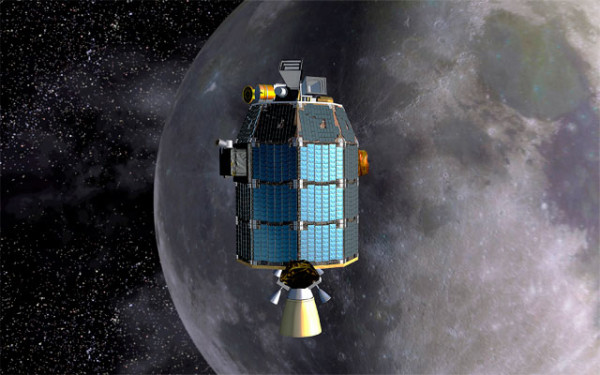 NASA’s most recent mission, launched in 2013, to explore the moon in greater detail recently won acclaim for its innovative approach. The Lunar Atmosphere and Dust Environment Explorer (LADEE) mission was awarded the 10th annual Popular Mechanics Breakthrough Award for innovation in science and technology.
NASA’s most recent mission, launched in 2013, to explore the moon in greater detail recently won acclaim for its innovative approach. The Lunar Atmosphere and Dust Environment Explorer (LADEE) mission was awarded the 10th annual Popular Mechanics Breakthrough Award for innovation in science and technology.
Among the innovations cited in the 2014 award from Popular Mechanics, were LADEE’s modular flexible construction and laser data transfer capability. Using this method of data transfer, LADEE can send and receive data more than six times faster than the quickest of space-based radio signals.

“We’re proud of the LADEE mission’s accomplishments and this recognition,” said S. Pete Worden, director of NASA’s Ames Research Center in Moffett Field, California, which designed, developed, built, integrated, tested and controlled the spacecraft. “LADEE may have been the first Ames-built spacecraft, but after the Kepler mission’s win in 2009 and the Lunar Crater Observation and Sensing Satellite (LCROSS) mission’s win in 2010, it’s the third Ames mission to be honored with this award.”
On its mission LADEE gathered detailed information on the structure and composition of our moon’s thin atmosphere. The goal was to determine whether dust is being lofted into the lunar sky.
The highlighted Lunar Laser Communication Demonstration (LLCD) terminal within the car-sized spacecraft, which demonstrated record-breaking upload and download speeds, was part of a cooperative mission with a team from NASA’s Goddard Space Flight Center and MIT’s Lincoln Laboratory. The platform has revealed the possibility of expanding broadband capabilities in future space communications development.
The design team at Ames constructed LADEE using a Modular Common Spacecraft Bus architecture. This design resulted in a lightweight carbon composite weighing 547.2 pounds unfueled and 844.4 pounds when fully fueled.
“This mission put the innovative common bus design to the test and proved the spacecraft could perform well beyond our most conservative estimates,” said Butler Hine, LADEE project manager at Ames. “This same common bus can be used on future missions to explore other destinations, including voyages to orbit and land on the moon, low-Earth orbit, near-Earth objects and objects in deep space.”
LADEE came to an end when the spacecraft was purposefully commanded to crash into the surface of the moon on April 18th after 100 days of data collection.
“From beginning to end, LADEE was a testament of unparalleled teamwork and unique innovation,” said Joan Salute, LADEE program executive at NASA Headquarters in Washington.” The mission established a new technology paradigm, opening a new chapter for spacecraft design and construction.”
![Herbal Reference Substances are Key to Everyday Products <!-- AddThis Sharing Buttons above -->
<div class="addthis_toolbox addthis_default_style " addthis:url='http://newstaar.com/herbal-reference-substances-are-key-to-everyday-products/3512112/' >
<a class="addthis_button_facebook_like" fb:like:layout="button_count"></a>
<a class="addthis_button_tweet"></a>
<a class="addthis_button_pinterest_pinit"></a>
<a class="addthis_counter addthis_pill_style"></a>
</div>When it comes to quality control testing and the development of new products, Botanical Reference Materials (BRMs), also known as Herbal References are critically important. To help companies ultimately obtain all-important FDA approval, the Food and Drug Administration provides in its guidance a recommendation that […]<!-- AddThis Sharing Buttons below -->
<div class="addthis_toolbox addthis_default_style addthis_32x32_style" addthis:url='http://newstaar.com/herbal-reference-substances-are-key-to-everyday-products/3512112/' >
<a class="addthis_button_preferred_1"></a>
<a class="addthis_button_preferred_2"></a>
<a class="addthis_button_preferred_3"></a>
<a class="addthis_button_preferred_4"></a>
<a class="addthis_button_compact"></a>
<a class="addthis_counter addthis_bubble_style"></a>
</div>](http://newstaar.com/wp-content/uploads/2021/02/Achillea_millefolium_flowers-100x100.jpg)
![Quality Electrochemical Biosensors are Critical for Medical, Food and Chemical Industry <!-- AddThis Sharing Buttons above -->
<div class="addthis_toolbox addthis_default_style " addthis:url='http://newstaar.com/quality-electrochemical-biosensors-are-critical-for-medical-food-and-chemical-industry/3512086/' >
<a class="addthis_button_facebook_like" fb:like:layout="button_count"></a>
<a class="addthis_button_tweet"></a>
<a class="addthis_button_pinterest_pinit"></a>
<a class="addthis_counter addthis_pill_style"></a>
</div>A number of industries have, at their core, a need to frequent or even continuous analysis of biological media. These include the medical and pharmaceutical fields, biotech firms, and food and chemical companies. To maintain quality standards and develop new products, these industries rely heavily […]<!-- AddThis Sharing Buttons below -->
<div class="addthis_toolbox addthis_default_style addthis_32x32_style" addthis:url='http://newstaar.com/quality-electrochemical-biosensors-are-critical-for-medical-food-and-chemical-industry/3512086/' >
<a class="addthis_button_preferred_1"></a>
<a class="addthis_button_preferred_2"></a>
<a class="addthis_button_preferred_3"></a>
<a class="addthis_button_preferred_4"></a>
<a class="addthis_button_compact"></a>
<a class="addthis_counter addthis_bubble_style"></a>
</div>](http://newstaar.com/wp-content/uploads/2020/10/Electrochemical-Biosensor-100x100.jpg)
![Company Develops Industrial Mixers Well-Suited for both Fragile and Explosive Products <!-- AddThis Sharing Buttons above -->
<div class="addthis_toolbox addthis_default_style " addthis:url='http://newstaar.com/company-develops-industrial-mixers-well-suited-for-both-fragile-and-explosive-products/3512071/' >
<a class="addthis_button_facebook_like" fb:like:layout="button_count"></a>
<a class="addthis_button_tweet"></a>
<a class="addthis_button_pinterest_pinit"></a>
<a class="addthis_counter addthis_pill_style"></a>
</div>Industrial drum mixers are normally applied to blend mixes of varying viscosities such as adhesive slurries or cement. Some of these mixers have the capability of blending mixes of very different particle sizes such as fruit and ice cream, and gravel and cement slurry. The […]<!-- AddThis Sharing Buttons below -->
<div class="addthis_toolbox addthis_default_style addthis_32x32_style" addthis:url='http://newstaar.com/company-develops-industrial-mixers-well-suited-for-both-fragile-and-explosive-products/3512071/' >
<a class="addthis_button_preferred_1"></a>
<a class="addthis_button_preferred_2"></a>
<a class="addthis_button_preferred_3"></a>
<a class="addthis_button_preferred_4"></a>
<a class="addthis_button_compact"></a>
<a class="addthis_counter addthis_bubble_style"></a>
</div>](http://newstaar.com/wp-content/uploads/2020/06/bandeau-sofragir2-100x100.jpg)